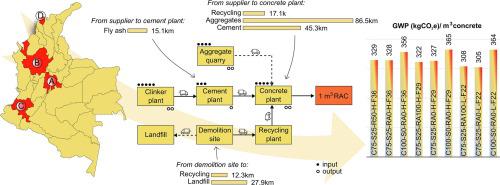Geoscience Frontiers ( IF 8.5 ) Pub Date : 2021-05-21 , DOI: 10.1016/j.gsf.2021.101235 Marian Sabău , Dan V. Bompa , Luis F.O. Silva

|
This work examines the environmental and geochemical impact of recycled aggregate concrete production with properties representative for structural applications. The environmental influence of cement content, aggregate production, transportation, and waste landfilling is analysed by undertaking a life cycle assessment and considering a life cycle inventory largely specific for the region. To obtain a detailed insight into the optimum life cycle parameters, a sensitivity study is carried out in which supplementary cementitious materials, different values of natural-to-recycled aggregate content ratio and case-specific transportation distances were considered. The results show that carbon emissions were between 323 and 332 kgCO2e per cubic metre of cement only natural aggregate concrete. These values can be reduced by up to 17% by replacing 25% of the cement with fly ash. By contrast, carbon emissions can increase when natural coarse aggregates are replaced by recycled aggregates in proportions of 50% and 100%, and transportation is not included in analysis. However, the concrete with 50% recycled aggregate presented lower increase, only 0.3% and 3.4% for normal and high strength concrete, respectively. In some cases, the relative contribution of transportation to the total carbon emissions increased when cement was replaced by fly ash in proportions of 25%, and case-specific transportation distances were considered. In absolute values, the concrete mixes with 100% recycled aggregates and 25% fly ash had lower carbon emissions than concrete with cement and natural aggregates only. Higher environmental benefits can be obtained when the transportation distances of fly ash are relatively short (15–25 km) and the cement replacement by fly ash is equal or higher than 25%, considering that the mechanical properties are adequate for practical application. The observations from this paper show that recycled aggregate concrete with strength characteristics representative for structural members can have lower carbon emissions than conventional concrete, recommending them as an alternative to achieving global sustainability standards in construction.
中文翻译:

再生混凝土和天然骨料混凝土的碳排放比较评估:水泥含量对环境的影响
这项工作研究了再生骨料混凝土生产对环境和地球化学的影响,其具有代表结构应用的特性。水泥含量、骨料生产、运输和垃圾填埋对环境的影响通过进行生命周期评估并考虑主要针对该地区的生命周期清单进行分析。为了详细了解最佳生命周期参数,进行了敏感性研究,其中考虑了补充胶凝材料、天然与再生骨料含量比的不同值以及特定情况下的运输距离。结果表明,碳排放量在323和332 kgCO 2 之间e 每立方米水泥只能使用天然骨料混凝土。通过用粉煤灰代替 25% 的水泥,这些值最多可降低 17%。相比之下,当天然粗骨料以 50% 和 100% 的比例被再生骨料替代时,碳排放量会增加,并且分析中不包括运输。然而,含有 50% 再生骨料的混凝土表现出较低的增长,普通和高强混凝土分别仅为 0.3% 和 3.4%。在某些情况下,当水泥以 25% 的比例被粉煤灰替代时,运输对总碳排放的相对贡献增加,并考虑了具体的运输距离。在绝对值中,与仅使用水泥和天然骨料的混凝土相比,使用 100% 再生骨料和 25% 粉煤灰混合的混凝土的碳排放量更低。当粉煤灰的运输距离较短(15-25km)且粉煤灰替代水泥等于或高于25%时,考虑到其力学性能足以满足实际应用,可以获得更高的环境效益。本文的观察结果表明,具有代表结构构件强度特性的再生骨料混凝土比传统混凝土具有更低的碳排放,推荐它们作为实现全球建筑可持续性标准的替代方案。当粉煤灰的运输距离较短(15-25km)且粉煤灰替代水泥等于或高于25%时,考虑到其力学性能足以满足实际应用,可以获得更高的环境效益。本文的观察结果表明,具有代表结构构件强度特性的再生骨料混凝土比传统混凝土具有更低的碳排放,推荐它们作为实现全球建筑可持续性标准的替代方案。当粉煤灰的运输距离较短(15-25km)且粉煤灰替代水泥等于或高于25%时,考虑到其力学性能足以满足实际应用,可以获得更高的环境效益。本文的观察结果表明,具有代表结构构件强度特性的再生骨料混凝土比传统混凝土具有更低的碳排放,推荐它们作为实现全球建筑可持续性标准的替代方案。











































 京公网安备 11010802027423号
京公网安备 11010802027423号